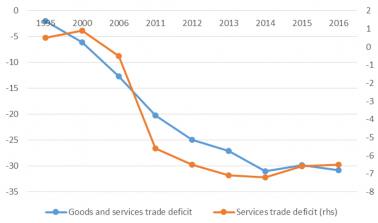



Anubhav SahuMoneycontrol research
Trump-Modi meet was high on symbolism starting from Trump’s tweet for Modi as a “True” friend, and ending with the official dinner (first under Trump’s administration for a visiting dignitary). However, they both found a common ground in ‘terrorism’ (probably the only “win” from this meeting) and most of the so-called contentious issues that were relevant for Indian businesses were carefully or deliberately avoided.
On the face of it, it may appear as a nice state-recognition. One might recall that a similar grand welcome was organised for Chinese premier Xi Jinping (Mar-a-Lago resort). However, it’s another matter that while the Chinese premier was still in US, Trump decided to strike Syria, an ally of China.
Trump-Merkel meet, on the other hand was a template reference that an assertive visiting leader’s stance on issues not palatable to the US can be unproductive. So, probably diplomats on both sides kept the agenda appropriately positioned.
Trump’s meet was high on agenda important for the US like jobs creation, business deals in defence, energy and airlines. Terrorism and international defense cooperation were other topics of significance which went some way to strengthening India’s stance on geo-politics.
Trump mentioned about Indian Airlines recently ordering 100 new American planes, “…. which will support thousands and thousands of American jobs” in his press statement. At the same time he also showed keenness for exporting more American energy to India including major long-term contracts to purchase American natural gas.
Modi in a separate communication to Wall Street Journal mentioned that India might import energy in excess of USD 40 billion and add 200 US-made aircraft in coming years.
Trump had been quite categorical in mentioning trade deficit with India (USD 30.8 billion trade and services deficit in 2016) and asking the sub-continent to reduce import barriers.
Interestingly, US trade and services deficit with India is at USD 30.8 billion, as per the office of US trade representative, and has remained stagnant at this level for the last three years. At the same time, services trade as a source of trade deficit has actually reduced in the last two years. US services trade balance with India has narrowed from (-) USD 7.2 billion in 2014 to (-) USD 6.5 billion.
Although services deficit has narrowed, the much debated issue of H1-B visas didn’t find a mention in the official reporting.
US-India goods and services trade balance (USD billion)

Source: moneycontrol research
However, a major victory from India’s perspective was the recognition of India’s role in the multi-polar set-up. Trump applauded India’s effort in maintaining stability in Afghanistan. He apparently mentioned counting on India’s support for the isolation of North Korea and offered cooperation on naval exercises in the Indian ocean. As a consolation for India, USA named Syed Salahuddin, leader of Hizbul Mujahideen as a Specially Designated Global Terrorist. This was perhaps the only balm for a nation that is facing multiple challenges from difficult neighbors.
Overall, this seems to be a modest beginning for the Trump-Modi era of US-India relation. Trump-Modi meet was high on symbolism, skipped some crucial topics of India’s interest but recognized India’s role in the multi-polar world. On the edge, it rehashes India’s geo-political role in Asia which was under a shadow since Trump-Xi’s bonhomie on countering North Korea.
Discover the latest Business News, Sensex, and Nifty updates. Obtain Personal Finance insights, tax queries, and expert opinions on Moneycontrol or download the Moneycontrol App to stay updated!
Find the best of Al News in one place, specially curated for you every weekend.
Stay on top of the latest tech trends and biggest startup news.